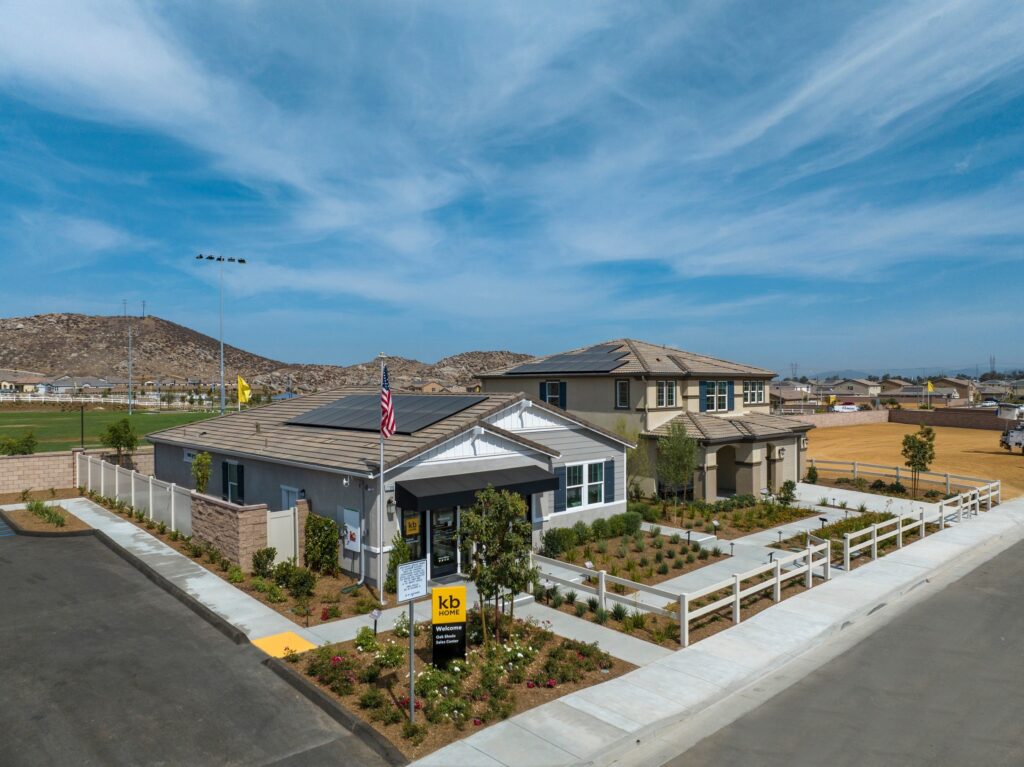 SunPower Corp., University of California, Irvine, Schneider Electric, and Southern California Edison announced their collaboration with KB Home, as the strategy, research, technology, and energy providers for the homebuilder’s newly launched Energy-Smart Connected Communities in Menifee, California. More than 200 state-of-the-art, all-electric homes will be solar-powered, equipped with individual battery storage, and connected to a microgrid powered by a large, shared community battery. These power-outage-resistant communities are the first of their kind in the state and are designed to offer a blueprint for sustainable and resilient new home development of the future.
SunPower Corp., University of California, Irvine, Schneider Electric, and Southern California Edison announced their collaboration with KB Home, as the strategy, research, technology, and energy providers for the homebuilder’s newly launched Energy-Smart Connected Communities in Menifee, California. More than 200 state-of-the-art, all-electric homes will be solar-powered, equipped with individual battery storage, and connected to a microgrid powered by a large, shared community battery. These power-outage-resistant communities are the first of their kind in the state and are designed to offer a blueprint for sustainable and resilient new home development of the future.
Residential energy use accounts for roughly 20% of greenhouse gas emissions in the U.S., contributing to more severe and frequent weather events. Between 2013 and 2020, blackouts caused by events such as snowstorms, wildfires, and hurricanes have tripled in duration, according to the latest data from the U.S. Energy Information Administration.
KB Home, SunPower, and UCI joined forces to reimagine what a new home community could look like if built to reduce carbon emissions, cut energy costs, and provide new ways of producing reliable and resilient energy. With a $6.65 million Department of Energy (DOE) grant, microgrid design and engineering support from Schneider Electric, and strong collaboration with SCE to ensure a smooth transition between grid and off-grid electricity, these innovative homes are now available to the public.
“SunPower and KB Home have a long-standing history of leading the new home industry with energy innovation and sustainability,” said Matt Brost, Vice President of Sales, New Homes, at SunPower. “With this project, we are taking a large leap toward creating communities from the ground up that are designed to produce sustainable and affordable energy and resiliency to the impacts of climate change on our grid. We are thrilled to leverage our learnings from this project to influence continued innovation in homebuilding.”
Purpose-Built for Sustainability and Resilience
All 219 of the homes in the new Durango and Oak Shade communities will be built to meet the Department of Energy’s Zero Energy Ready Home criteria, which include ENERGY STAR®, WaterSense, and Indoor airPLUS. These additional features could help homeowners reduce average energy use by up to 40%. Each home comes with a SunPower Equinox® solar system designed to achieve net-zero energy, a 13kWh SunVault® Storage battery, high-efficiency appliances, flexible loads such as electric heat pump water heaters and HVAC systems and other smart technologies like Schneider Electric’s Square D™ Energy Center and Connected Wiring Devices.
All homes will be pre-wired to be smart Electric vehicle (EV) charger-ready, and some will demonstrate bidirectional charging, which enables an EV to be an additional source of energy for the home during a power outage. EV chargers will be available for purchase at the time of sale.
These communities offer a new vision for how individual homes interact with the electrical grid. Every home, while maintaining its regular service with local utility Southern California Edison, is designed to operate during an outage as part of a self-supporting microgrid, drawing energy from its own SunVault storage system as well as a large community battery. Together, they are designed to support critical loads such as lights, refrigeration, and WiFi, as well as additional high-capacity loads like HVAC and domestic hot water. When the sun is shining, individual and community batteries can be continually recharged using excess solar generation until the grid connection returns.
Additional energy services offered by SunPower allow residents to enroll in a Virtual Power Plant (VPP) program through which their battery storage, EV chargers, and other flexible loads can automatically dispatch to support the electric grid. Enrolled homeowners may be eligible for compensation for their participation in the program. UCI will also simulate the connected microgrids, analyze data from the VPP program, and collaborate with SCE to determine its effectiveness in supporting grid infrastructure.
Leave a Reply